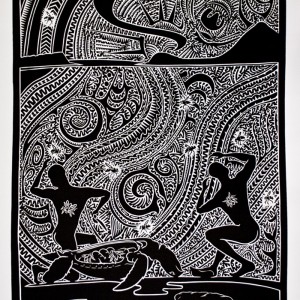Umbrella Print Commission: Hillside Moondaraby Vincent Bray
Vincent Bray, Hillside Moondara, 2020.
Hand-coloured relief print on Dutch Etching paper, 25 x 18.5cm (print), 38 x 28cm (paper).
Edition of 30 created for Umbrella’s 2020 Print Commission.
Members’ Price:
$85 print
Become a member here ($50 or $40 concession) or log in to receive your members’ discount.
Non-members’ Price (including organisations):
$185 print
Discounted Bundle
$240 bundle price (members) for three prints
$500 bundle price (non-members)
Purchase the bundle and read about the other prints here.
Umbrella’s inaugural Print Commission was made possible through the generous support of Ron McBurnie of Monsoon Publishing. This print was also made possible by the hand-colouring efforts of Umbrella’s volunteers – we thank them immensely for their time and contribution.
$185.00 inc. GST
29 in stock
About the artist

“I was born in Mount Isa in 1933. I went to school there until about Grade Five. After three years in Grade Five the nuns told my parents I would be better off at work. I then had various jobs from telegram boy, washing bottles in a cordial factory to even message boy at the local hospital. Then in the fifties I decided to try life in a religious order. That was my first trip to Sydney. What a shock. All these people all running around like ants when you hit their nest with a stick. I will never forget my first week there. I was given lessons in table manners and etiquette. Eating y fruit with a knife and fork for breakfast, peeling plumbs with a knife and fork, never heard of it. Well after two years I decided religious life was not for me.
After returning to Mount Isa I stayed awhile and then left to do volunteer work on the missions. I spent a number of years on the Daly River in N.T. and Mount Hagen in New Guinea as a truck driver, handyman, mechanic and welding frames for buildings. I returned to Mount Isa in the late G0’s. Got a job with Mount Isa Mines working underground on various jobs for about ten years. I got a job on one of the cages as platman (lift operator) and for the next fifteen years I worked as a platman on R-62 and P-61 cages until I returned and moved to Townsville. When I came home from New Guinea I lived in the single men’s barracks at the mine lease. I found life very boring until one day I had a relapse of malaria. While I was out getting medication I bought a couple of magazines and a little paperback called HOW TO PAINT AND DRAW. And the rest is history as luck seems to fall my way. It was about then Mervyn Moriarty started his Flying Arts School. My sister-in-law, Ailsa, walked into the room and saw 8 to 10 women sitting around in a circle. I thought Gees how do I get out of here and thanks to my friend Margaret even today still saw my inhibition and made me feel at ease. Even though they were painting little square blocks of colour it seemed a little strange. After a few years Mervyn ran out of money and the Flying Arts School folded for a number of years but for Bela lvanyi, who was Mervyn’s offsider in the Flying Arts School. Bela then started what became known as The Cooee Bay Art Camp that just celebrated its 25th anniversary. Every year we would meet at Cooee Bay Fitness Camp for twelve days of hard sometimes frustrating work. Bela brought with him every year a guest tutor from Australia’s top artists. Just to name a few: Anne Thompson, Rod Milgate, Max Miller, John Wolseley and Andrew Sibley. I went for about fifteen years.
As for printmaking, my first introduction to it was by Bryan Dean who was the lithograph tutor at what was then the T.A.F.E. College at Kelvin Grove in Brisbane where I was having my first show. He gave me a stone and pencil and things and asked me to put a drawing on the stone and he would print it. He sent me four of them later. Even though he tried to tell me about it, it was years before I understood, thanks to Anne Lord who came to Mount Isa some years later. I was impressed by her little woodcuts on snappy gum (a scrubby tree) so next holidays I bought some wood cutting tools but quickly learned it was not as easy as Anne made it look. Next came on etching on zinc plate. My friend Jo Forster told me about it and so I quickly got myself there and now I am trying to learn more about the technique of printmaking but keeping in touch with my painting.”
















